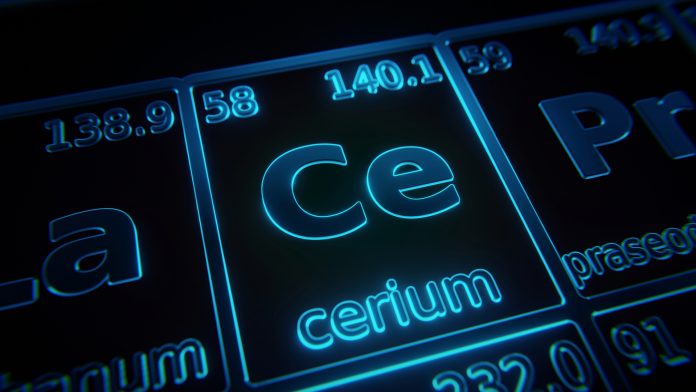Researchers from the University of Michigan have discovered why cerium flow batteries that have a sulphuric acid electrolyte lose voltage. This is set to pave the way for better battery chemistry.
Flow batteries are a potential method for storing intermittent sources of renewable energy, such as solar and wind power. They can store large quantities of energy by keeping the chemical potential in liquid form, with two electrolytes that flow through porous electrodes to charge and discharge. Cerium has the potential to store energy at a high voltage, meaning more energy per metal ion, and at a low cost.
However, using cerium comes with challenges, as it is difficult to work out how to make electric charges transfer to and from the electrode efficiently. Depending on whether the battery is charging or discharging, cerium either picks up or drops off an electron on its way through the positive electrode. Cerium in a sulphuric acid electrolyte does not pick up and drop off the electron as quickly as expected, however, meaning that energy is wasted.
To overcome this problem, researchers from the University of Michigan studied how cerium ions behave in acidic electrolytes during charge transfer. This will pave the way for more efficient cerium-based batteries in the future.
The study, titled ‘Unveiling the Cerium(III)/(IV) Structures and Charge-Transfer Mechanism in Sulfuric Acid,’ is published in JACS Au.
Closely observing cerium
The team observed what happened when cerium picked up and dropped off electrons, using X-ray absorption to look at bonds between the cerium, sulphates, and water. The experiments were conducted at Argonne National Laboratory, following computer simulations led by Bryan Goldsmith, the Dow Corning Assistant Professor of Chemical Engineering at U-M.
“We find that when cerium is short three electrons, it is only surrounded by water molecules, while when it gives up that fourth electron, sulphate or bisulphate ions are hanging off the cerium ion,” said Nirala Singh, U-M Assistant Professor of chemical engineering and corresponding author of the study, who led the experiment.
“As a result of this, when we oxidise cerium by taking away that electron, or reduce it by giving the electron back, both an electron transfer has to occur and the molecules around it have to rearrange.”

Going further than Marcus theory
Through understanding the energy associated with this structural arrangement, the team explained why the reaction is asymmetrical where the oxidation and reduction behave differently. This discovery rendered Marcus theory, the go-to theory for predicting the rates of electron transfer, inadequate. The researchers found that it is possible to use Marcus theory to figure out the electron transfer piece but then added in the effects of rearrangement in a two-step process.
“The uneven complexation between the oxidised and reduced forms of cerium causes reaction rates to slow down, and this knowledge will inform electrolyte design strategies for cerium or other similar flow batteries,” said Singh.
Using the team’s method in the future
The researchers’ two-step method will help identify electrolytes that have fast reaction rates and yield high efficiencies. The goal is to use electrolytes that will not store different amounts of energy in the areas around the oxidised or reduced cerium ion.
“Through this study, we have a better understanding of how cerium ions behave in acidic electrolytes during charge transfer,” said Cailin Buchanan, a recent U-M doctoral graduate in chemical engineering and first author of the paper.
“This understanding will help us and future researchers to design more efficient cerium-based batteries that have less voltage loss during charging and discharging.”
As well as new initiating new opportunities in grid-scale energy storage, the team’s findings could improve other chemical processes that rely on cerium, for example, the manufacturing of carbon-based products and wastewater decontamination.









